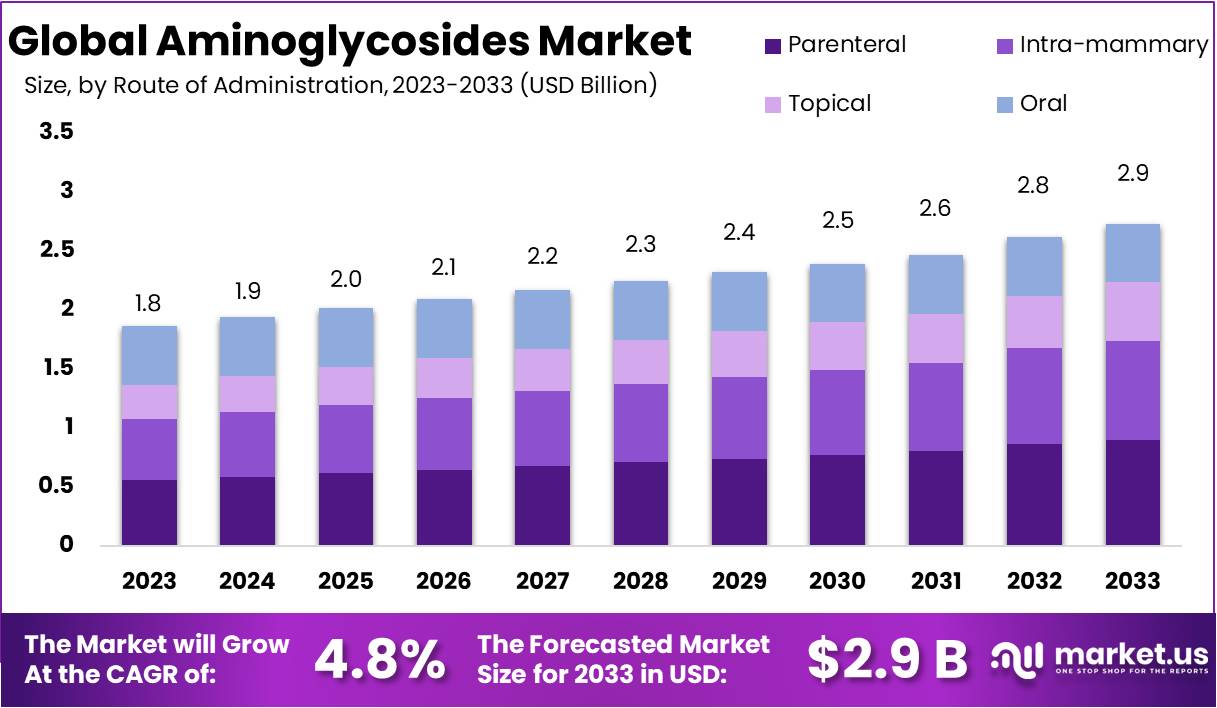Introduction
The Aminoglycosides Market is poised for robust growth, with projections indicating an expansion from USD 1.8 billion in 2023 to USD 2.9 billion by 2033. This reflects a steady Compound Annual Growth Rate (CAGR) of 4.8% from 2024 to 2033. Central to this growth is the escalating challenge of antibiotic resistance, which underscores the necessity for effective treatments against resistant bacteria. Aminoglycosides, known for their efficacy against Gram-negative bacteria, are critical in addressing these persistent infections.
Innovations in aminoglycoside drug development are also driving market expansion. Efforts are particularly focused on modifying aminoglycoside molecules to diminish their inherent side effects, such as ototoxicity, while boosting their therapeutic efficacy. The development of semi-synthetic aminoglycosides is a significant stride towards enhancing patient outcomes and broadening the clinical utility of these drugs. Additionally, ongoing research into the biosynthetic pathways of aminoglycosides is paving the way for the discovery of novel antibiotics, potentially vital in a future dominated by drug-resistant pathogens.
Regulatory advancements and improved monitoring protocols contribute significantly to the market’s growth. Enhanced dosing guidelines and the strategic management of administration schedules are crucial for maximizing therapeutic effectiveness while minimizing adverse effects. The expanded clinical use of aminoglycosides, including their combination with other antibiotics for synergistic effects, is particularly notable in the treatment of severe and acute infections, where alternatives may be ineffective.
Recent strategic developments within the industry also highlight the dynamic nature of the aminoglycosides market. In November 2023, Pfizer acquired Nektar Therapeutics for $7.5 billion, a move that strengthens Pfizer’s position in the antibiotics market, particularly within the aminoglycosides segment. This acquisition focuses on the rapid development and potential commercialization of Nektar’s lead candidate, NKT-477, which is in Phase 3 trials for treating multidrug-resistant Pseudomonas aeruginosa infections.
Furthermore, the collaboration between Sanofi and Samsung Biologics to develop Novel Aminoglycoside Conjugates merges Sanofi’s expertise in aminoglycosides with Samsung’s capabilities in antibody-drug conjugate technology. This partnership aims to produce targeted aminoglycosides that deliver treatments directly to infection sites, thus enhancing efficacy and reducing side effects. Additionally, the merger of Astellas and Entasis Therapeutics into Atairos marks a significant shift towards enhancing the development pipeline for aminoglycosides and other antibacterial agents, with Entasisn being a prominent candidate in their portfolio. This strategic fusion leverages combined resources and expertise, potentially accelerating the entry of new antimicrobial solutions into the market.

Key Takeaways
- The aminoglycosides market is expected to expand at a 4.8% CAGR, reaching USD 2.9 billion by 2033 from USD 1.8 billion in 2023.
- Gentamicin leads with a 32.5% market share, preferred for its proven effectiveness.
- Parenteral administration is favored for its quick response in severe infections, capturing a 30.8% market share.
- The respiratory diseases segment accounts for 41.6% of the market due to increasing respiratory health issues.
- Asia-Pacific holds a 41.5% market share, driven by growing healthcare demands and economic progress.
- Rising global bacterial infections are boosting the demand for aminoglycosides.
- Emerging markets present significant growth opportunities, particularly in the Asia-Pacific region.
- Research into new compounds and personalized treatments is paving the way for market expansion.
- Safety concerns, including risks of ototoxicity and nephrotoxicity, restrict aminoglycoside use.
- The trend of using aminoglycosides with other antibiotics is enhancing treatment effectiveness.
Emerging Trends
- Revival Due to Antibiotic Resistance: The prevalence of multidrug-resistant bacteria has reignited interest in aminoglycosides. These antibiotics are known for their broad-spectrum efficacy, making them crucial in cases where other treatments are ineffective. Their ability to combat severe infections highlights their significance in contemporary medicine, despite concerns over resistance.
- Innovation through New Derivatives: In response to rising resistance and side effects associated with traditional aminoglycosides, researchers are developing new derivatives. Plazomicin stands out as a next-generation aminoglycoside, specifically engineered to tackle bacteria that have become resistant to other antibiotics. This advancement is pivotal for enhancing treatment effectiveness and reducing adverse effects.
- Broader Medical Applications: Aminoglycosides are branching out from their conventional role in treating bacterial infections. Current research is investigating their utility in genetic disorders, particularly those involving premature stop codons. Additionally, their potential as inhibitors of the SARS-CoV-2 main protease is under exploration, which could open new avenues for antiviral therapies.
Use Cases
- Treatment of Severe Infections: Aminoglycosides are crucial in managing severe infections, including sepsis and infections acquired in hospitals. A significant study observed 931 ICU patients with septic shock, where aminoglycosides were the primary treatment. Among these, 66% received amikacin, 33% were treated with gentamicin, and 1% with tobramycin. These antibiotics are valued for their effectiveness in critical care settings, underscoring their role in treating life-threatening conditions.
- Single-Dose Therapy for UTIs: For lower urinary tract infections (UTIs), single-dose aminoglycoside therapy proves highly effective. A comprehensive review involving 13,804 patients across 13 studies highlighted a microbiologic cure rate of 94.5%. Notably, the therapy also demonstrated a low incidence of adverse effects, affecting only 0.5% of the patients. This approach not only simplifies treatment but also enhances patient compliance and outcomes.
- Use in Critically Ill Patients: Aminoglycosides are frequently used in intensive care units for empirical therapy against severe infections. Despite their widespread use, there’s considerable variability in how they are dosed and monitored. This variability points to the urgent need for standardized guidelines. Establishing such guidelines would help optimize treatment efficacy and reduce the risks of toxicity, thereby improving patient safety in critical care scenarios.
Regional Analysis
In 2023, the Aminoglycosides Market in the Asia-Pacific (APAC) region demonstrated a robust performance, capturing over 41.5% of the global market share. The region’s market value reached USD 0.747 billion, indicating its significant influence in the sector. This growth is attributed to the rising healthcare demands of its expanding population and the growing recognition of aminoglycosides’ therapeutic benefits.
APAC’s market dynamics are further driven by rapid economic growth, enhanced healthcare infrastructure, and increased healthcare spending due to higher disposable incomes. These factors have collectively fueled the demand for aminoglycosides, making APAC a central player in the global market.
Take advantage of our unbeatable offer - buy now!

China, as APAC’s largest market, significantly shapes the regional market trends. Its extensive pharmaceutical sector and strong research and development capabilities have propelled the market forward. Additionally, partnerships between global and local pharmaceutical companies have facilitated the launch of innovative aminoglycoside products, strengthening China’s market presence.
In India, the Aminoglycosides Market has seen remarkable growth due to a large patient base, heightened healthcare awareness, and emphasis on affordable medical treatments. Technological advancements in India’s pharmaceutical industry have boosted the production and distribution of aminoglycosides, contributing to the region’s market expansion. Meanwhile, North America and Europe also maintain substantial market shares, supported by their advanced healthcare systems and continuous R&D efforts.
Conclusion
The aminoglycosides market is set for steady growth, driven by increasing bacterial infections and the urgent need for effective antibiotics. Their proven effectiveness against resistant bacteria makes them crucial in treating severe infections. Advancements in drug modifications, including reduced side effects and improved formulations, are expanding their clinical use. Strategic mergers, acquisitions, and research collaborations are further shaping the market, leading to the development of next-generation aminoglycosides. The Asia-Pacific region remains a key growth driver due to rising healthcare needs and pharmaceutical advancements. While safety concerns persist, the growing demand for combination therapies and innovative treatments highlights the market’s evolving landscape, ensuring its continued relevance in the global healthcare sector.
Discuss your needs with our analyst
Please share your requirements with more details so our analyst can check if they can solve your problem(s)



